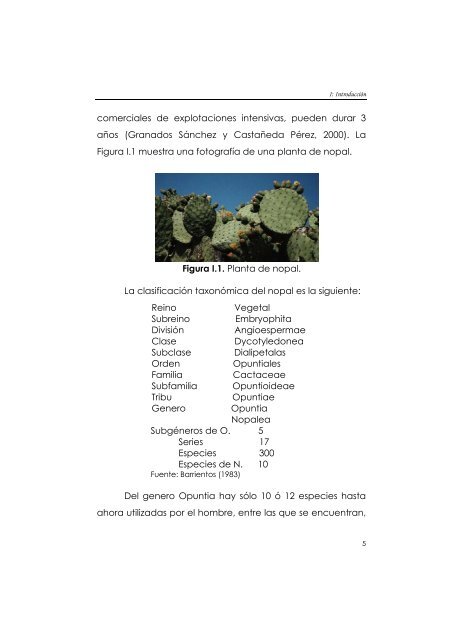- Page 1: UNIVERSIDAD POLITÉCNICA DE VALENCI
- Page 5: Dedico este trabajo a: A toda mi fa
- Page 9 and 10: RESUMEN El presente trabajo tiene c
- Page 11: RESUM El present treball té com a
- Page 14 and 15: Índice de Contenidos 3.1.3.2. Comp
- Page 17 and 18: INDICE DE ECUACIONES Índice de Ecu
- Page 19: Índice de Ecuaciones IV.8. 136 IV.
- Page 22 and 23: Índice de Figuras viscosidad de di
- Page 24 and 25: Índice de Figuras Figura IV.10. Ef
- Page 26 and 27: Índice de Tablas temperaturas. Tab
- Page 28 and 29: Índice de Tablas blancura en los f
- Page 30 and 31: Abreviaturas ESC Mucílago extraíd
- Page 33: 1.1. El nopal. 1.1.1. Generalidades
- Page 37 and 38: I: Introducción ante los nopalli (
- Page 39 and 40: I: Introducción “fico d’India
- Page 41 and 42: I: Introducción Forman parte de la
- Page 43 and 44: Tabla I.3. Composición química de
- Page 45 and 46: I: Introducción Como cerco. La ut
- Page 47 and 48: I: Introducción • industria prod
- Page 49 and 50: I: Introducción jarabes. Se encuen
- Page 51 and 52: I: Introducción efecto. Sin embarg
- Page 53 and 54: I: Introducción observó que la ap
- Page 55 and 56: I: Introducción Tabla I.4. Composi
- Page 57 and 58: I: Introducción insoluble de los a
- Page 59 and 60: I: Introducción En México hay una
- Page 61 and 62: I: Introducción Hammouch et al. (2
- Page 63 and 64: I: Introducción 1998). Pueden cont
- Page 65 and 66: I: Introducción • Ayudan a mejor
- Page 67 and 68: I: Introducción gases es más baja
- Page 69 and 70: I: Introducción polisacáridos o p
- Page 71 and 72: I: Introducción del mismo. Se pued
- Page 73 and 74: I: Introducción Se pueden incorpor
- Page 75 and 76: I: Introducción 1.2) se utiliza pa
- Page 77 and 78: I: Introducción Existen varias ecu
- Page 79 and 80: I: Introducción un espectrofotóme
- Page 81 and 82: I: Introducción El mucílago del n
- Page 83 and 84: I: Introducción determinado volume
- Page 85 and 86:
I: Introducción El presente trabaj
- Page 87:
I: Introducción que la pulpa se vu
- Page 91 and 92:
2.1. Objetivo general: II. Objetivo
- Page 93 and 94:
II. Objetivos y plan de trabajo tie
- Page 95:
II. Objetivos y plan de trabajo pos
- Page 99 and 100:
3.1. Materiales y Métodos 3.1.1. M
- Page 101 and 102:
III. Extracción y Caracterización
- Page 103 and 104:
3.1.2.1. Macrocomponentes III. Extr
- Page 105 and 106:
III. Extracción y Caracterización
- Page 107 and 108:
III. Extracción y Caracterización
- Page 109 and 110:
III. Extracción y Caracterización
- Page 111 and 112:
III. Extracción y Caracterización
- Page 113 and 114:
III. Extracción y Caracterización
- Page 115 and 116:
III. Extracción y Caracterización
- Page 117 and 118:
III. Extracción y Caracterización
- Page 119 and 120:
III. Extracción y Caracterización
- Page 121 and 122:
III. Extracción y Caracterización
- Page 123 and 124:
III. Extracción y Caracterización
- Page 125 and 126:
III. Extracción y Caracterización
- Page 127 and 128:
III. Extracción y Caracterización
- Page 129 and 130:
III. Extracción y Caracterización
- Page 131 and 132:
III. Extracción y Caracterización
- Page 133 and 134:
III. Extracción y Caracterización
- Page 135 and 136:
Tabla III.10. Parámetros del model
- Page 137 and 138:
III. Extracción y Caracterización
- Page 139 and 140:
Tabla III.12. Valores de las consta
- Page 141 and 142:
III. Extracción y Caracterización
- Page 143 and 144:
superior. III. Extracción y Caract
- Page 145 and 146:
III. Extracción y Caracterización
- Page 147 and 148:
muestras. III. Extracción y Caract
- Page 149 and 150:
III. Extracción y Caracterización
- Page 151 and 152:
III. Extracción y Caracterización
- Page 153 and 154:
1 mW aw 0,11 aw 0,23 aw 0,33 aw 0,4
- Page 155 and 156:
III. Extracción y Caracterización
- Page 157 and 158:
III. Extracción y Caracterización
- Page 159:
IV. DISEÑO Y CARACTERIZACIÓN DE L
- Page 162 and 163:
IV. Diseño y Caracterización de l
- Page 164 and 165:
IV. Diseño y Caracterización de l
- Page 166 and 167:
IV. Diseño y Caracterización de l
- Page 168 and 169:
IV. Diseño y Caracterización de l
- Page 170 and 171:
IV. Diseño y Caracterización de l
- Page 172 and 173:
IV. Diseño y Caracterización de l
- Page 174 and 175:
Tabla IV.3. Valores medios del gros
- Page 176 and 177:
IV. Diseño y Caracterización de l
- Page 178 and 179:
IV. Diseño y Caracterización de l
- Page 180 and 181:
IV. Diseño y Caracterización de l
- Page 182 and 183:
IV. Diseño y Caracterización de l
- Page 184 and 185:
IV. Diseño y Caracterización de l
- Page 186 and 187:
IV. Diseño y Caracterización de l
- Page 188 and 189:
IV. Diseño y Caracterización de l
- Page 190 and 191:
IV. Diseño y Caracterización de l
- Page 192 and 193:
IV. Diseño y Caracterización de l
- Page 194 and 195:
IV. Diseño y Caracterización de l
- Page 196 and 197:
Tabla IV.9. Valores medios y desvia
- Page 198 and 199:
IV. Diseño y Caracterización de l
- Page 200 and 201:
IV. Diseño y Caracterización de l
- Page 202 and 203:
IV. Diseño y Caracterización de l
- Page 204 and 205:
IV. Diseño y Caracterización de l
- Page 206 and 207:
IV. Diseño y Caracterización de l
- Page 208 and 209:
IV. Diseño y Caracterización de l
- Page 210 and 211:
IV. Diseño y Caracterización de l
- Page 212 and 213:
IV. Diseño y Caracterización de l
- Page 214 and 215:
IV. Diseño y Caracterización de l
- Page 216 and 217:
IV. Diseño y Caracterización de l
- Page 219 and 220:
V. Conclusiones y Recomendaciones
- Page 221 and 222:
V. Conclusiones y Recomendaciones d
- Page 223:
VI. BIBLIOGRAFÍA
- Page 226 and 227:
VI. Bibliografía ASTM. 2001. Stan
- Page 228 and 229:
VI. Bibliografía Debeaufort, F.,
- Page 230 and 231:
VI. Bibliografía production of gas
- Page 232 and 233:
VI. Bibliografía Hoagland, P.D. y
- Page 234 and 235:
VI. Bibliografía Opuntia dillenni
- Page 236 and 237:
VI. Bibliografía Mercado-Silva, E
- Page 238 and 239:
VI. Bibliografía improved ABTS rad
- Page 240 and 241:
VI. Bibliografía Stintzing, F.C.
- Page 242:
VI. Bibliografía Internacional sob
















